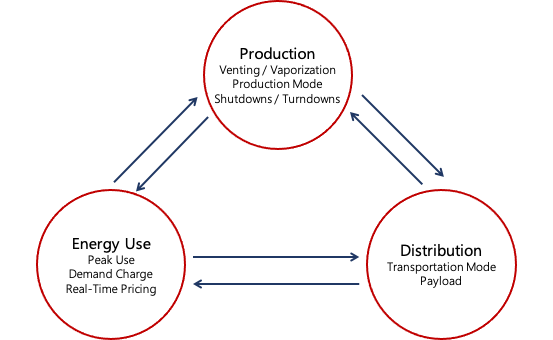Integrated Supply Chain Planning is the best way to be sure that you are running your business in a way that is best for your whole business. Developing a production plan independent of your distribution network or addressing capacity issues after you’ve decided what to make and when to make it will most likely result in missed opportunities and lost savings, while at the same time opening a potential for conflicts and firefighting down the road. It’s so much better to make the investment in a solution like Arkieva that will address all your supply chain issues in one integrated system.
In a similar vein, addressing your energy needs independent of your supply chain planning is another way to drive up costs unnecessarily and create rework. Industrial gas companies know this better than most because their production process is an extremely energy-intensive one. Keeping energy use to its minimum is a pinnacle of smart sustainable business practices. For industrial gas companies, it’s the only way. Precision energy management for them is critical, and they understand how dependent energy consumption is on their production processes and vice versa. Because of this, Arkieva has been an important partner in maintaining the tools to do this for multiple companies in this space. These clients have been pioneers in integrated energy and supply chain management.
Integrated Energy and Supply Chain Management
One such business operation is air separation. Meaning that they take air from, well, the air, and separate it into its individual gases – nitrogen, oxygen, and argon. This is accomplished by using different production modes, which determine the yields of each gas. One mode results in more oxygen and less nitrogen. Another mode leans in the opposite direction. They also make choices around venting and vaporizing gases that are unneeded yet part of the yield. On top of production decisions, they also must consider the distribution network, deciding which plant will be the source for each customer. This decision is based on proximity to the customer, but also on what’s going on at each plant. If there is a plant running a certain production mode, yielding gases for which only some nearby customers have demand, it may make sense to source a customer a little further away, because the plant is generating that gas anyway. Finally, they also make choices to shut down or turn down the units to reduce production during periods of the day when they would be charged peak prices for electricity. They can avoid shut-down/start-up costs and wear-and-tear on the unit by running during peak energy periods and take the hit on energy cost, or they can avoid the higher energy prices and incur shut-down/start-up costs. This is not a clear choice and is exactly why an optimization tool is so critical to their supply chain planning.

Why energy cost should not be included in standard production costs
For large industrial companies like these gas companies, the way they pay for electricity is very complicated. Energy costs are broken down into energy charges and demand charges.
The energy charge is the variable cost for energy (MWh) consumed. It is based on power level and duration. Rates can in certain cases change based upon peaks that are either predetermined in the contract or determined through market pricing. In addition, customers pay a demand charge, which is a fixed charge, based on maximum power requirements (MW) in each billing month. In other words, the highest level you hit for the month, no matter how briefly, sets the charge for the month. And it matters if you hit that high during on-peak or off-peak hours. Embedding a standard energy cost into the production cost would prevent planners from evaluating the impact of production timing on energy usage. Being able to balance production against energy usage to avoid peaks in energy usage can be critical.
We designed models to determine when to shut down and in what production modes to run to minimize peak electricity prices and demand charges, while also satisfying production requirements and taking into account distribution costs. In addition to production and distribution planning, this model is rare in that it integrates energy management into its supply chain management model. This is a great example of how integrating sustainability practices in your supply chain planning gets you closer to your sustainability goals without sacrificing performance and customer satisfaction. In fact, it enhances them. It’s a win-win.
Enjoyed this post? Subscribe or follow Arkieva on Linkedin, Twitter, and Facebook for blog updates.





